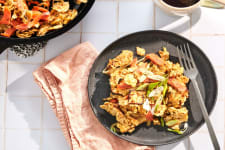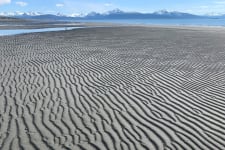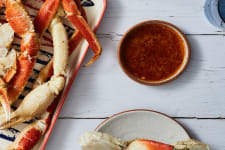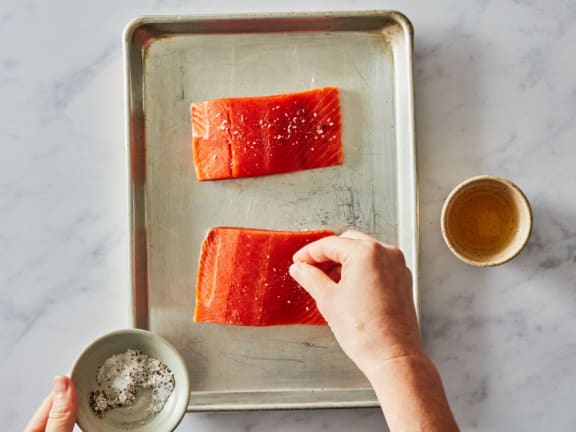
How to Cook Every Species of Fish in Your Combo Box
February 10th, 2025Essential Cooking Methods for Perfectly Cooked Fish
A Wild Combo Box from Wild Alaskan Company contains frozen portions of Sockeye Salmon, Coho Salmon, Pacific Halibut, Pacific Cod, and either Rockfish or Wild Alaska Pollock harvested from responsibly-managed fisheries in Alaska. With this variety of fish in your kitchen, you’ll be able to enjoy an exciting array of home-cooked meals. Each species included in the WAC Wild Combo Box has delicious nuances in flavor and texture that are best complemented by different preparations.
WAC’s cooking guides include step-by-step guidance on timing and techniques that will help you master essential cooking methods, whether you’re baking, broiling, or pan-frying fish.
Best Ways to Cook Wild Salmon
Both sockeye and coho salmon are naturally leaner than farmed Atlantic salmon. These prized qualities require a tailored approach to cooking salmon, since the cook times and recommended doneness for wild species differ from the times and temperatures for farmed varieties.
How to Bake Wild Salmon
 Overview of How to Bake Salmon:
Overview of How to Bake Salmon:
-
Preheat oven to 375F for classic baked salmon
-
Done in 8 to 15 minutes depending on cut and species of salmon
-
Easy, hands-off method for beginners
-
Great for building sheet pan meals, cooking for a crowd, and meal prepping
How to Broil Wild Salmon
 Overview of How to Broil Salmon:
Overview of How to Broil Salmon:
-
Done in 6 to 8 minutes depending on cut and species of salmon
-
A simple alternative to grilling wild salmon
-
Great method to pair with sauces, marinades, and rubs
-
Use the highest temp setting on your broiler
How to Pan-Fry Wild Salmon
 Overview of How to Pan-Fry Salmon:
Overview of How to Pan-Fry Salmon:
-
Done in 5 to 8 minutes depending on cut and species of salmon
-
Aim to sear at medium-high heat, using an oil with a high smoke point
-
Adds golden, crisp texture to fillets
-
Can use cast-iron, stainless steel, carbon steel, or non-stick skillets
How to Bake Salmon From Frozen
 Overview of Bake Salmon from Frozen:
Overview of Bake Salmon from Frozen:
-
Preheat oven to 425F
-
Cook time can take 25 to 30 minutes
-
Thinner tail cuts of salmon cook from frozen more evenly
-
Best paired with a sauce to enjoy moist, flaky fillets
How to Pan-Fry Salmon From Frozen
 Overview of Pan-Fry Salmon from Frozen:
Overview of Pan-Fry Salmon from Frozen:
-
Freezer to plate in under 15 minutes
-
Thinner tail cuts of salmon cook from frozen more evenly
-
Can enjoy crispy skin, even when cooked from frozen
-
Par-cook salmon first, then sear over medium-high heat
Best Ways to Cook Pacific Halibut
Pacific halibut is a world-renowned fish with a mild and subtly sweet taste, taking on a robustly meaty texture when cooked. Cooking Pacific Halibut requires some delicacy, though — it’s essential to keep a watchful eye on this species as it cooks to bring out its hearty flakiness.
How to Pan-Fry Pacific Halibut
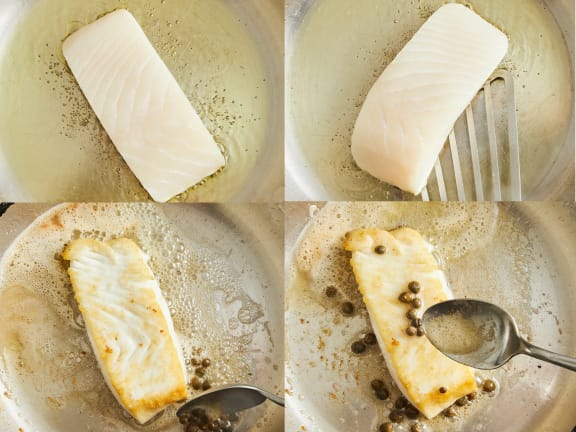 Overview of How to Pan-Fry Pacific Halibut:
Overview of How to Pan-Fry Pacific Halibut:
-
Done in 6 to 8 minutes depending on thickness
-
Aim to sear at medium-high heat, using an oil with a high smoke point
-
Adds a lightly golden, crisp texture to fillets
-
Can use cast-iron, stainless steel, carbon steel, or non-stick skillets
How to Bake Pacific Halibut
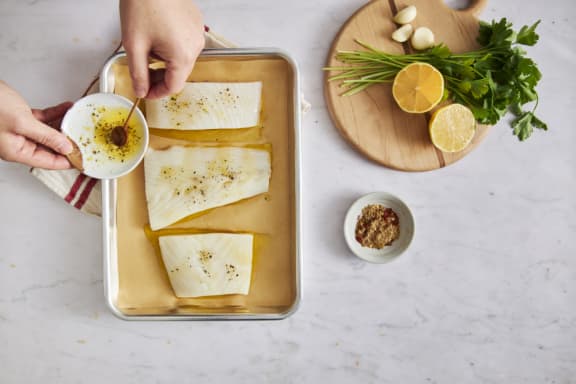 Overview of How to Bake Pacific halibut:
Overview of How to Bake Pacific halibut:
-
Preheat oven to 400F for classic baked Pacific halibut
-
Done in 8 to 10 minutes depending on thickness
-
Easy, hands-off method for beginners
-
Try baking en papillote for extra tender fillets
How to Broil Pacific Halibut
 Overview of How to Broil Pacific Halibut
Overview of How to Broil Pacific Halibut
-
Done in 5 to 6 minutes depending on thickness
-
A simple alternative to grilling Pacific halibut
-
Great method to pair with sauces, marinades, and rubs
-
Use the highest temp setting on your broiler
Best Ways to Cook Pacific Cod
Pacific cod is a mild white fish that can be used in a variety of preparations. Pacific cod is flaky when cooked, but maintains a slightly bouncy texture that gives it a pleasant chew — a substantial protein to use in tacos, casseroles, and stews, or even on its own as a blank canvas for sauces. Keeping an eye on its doneness is important, as it loses its flakiness when overcooked.
How to Bake Pacific Cod
 Overview of How to Bake Pacific Cod:
Overview of How to Bake Pacific Cod:
-
Preheat oven to 400F for classic baked Pacific cod
-
Done in 8 to 10 minutes depending on thickness
-
Easy, hands-off method for beginners
-
Try baking en papillote for extra tender fillets
How to Pan-Fry Pacific Cod
 Overview of How to Pan-Fry Pacific Cod:
Overview of How to Pan-Fry Pacific Cod:
-
Done in 6 to 8 minutes depending on thickness
-
Aim to sear at medium-high heat, using an oil with a high smoke point
-
Can use cast-iron, stainless steel, carbon steel, or non-stick skillets
-
Best served with a sauce
How to Broil Pacific Cod
 Overview of How to Broil Pacific Cod
Overview of How to Broil Pacific Cod
-
Done in 5 to 6 minutes spending on thickness
-
A better alternative to grilling Pacific Cod
-
Great method to pair with sauces, marinades, and rubs
-
Use the highest temp setting on your broiler
Best Ways to Cook Rockfish
Rockfish is a flavorful white fish whose robust taste pairs exceptionally well with bold ingredients. Despite being incredibly flaky, its firm texture holds together well over a variety of cooking methods. It’s also one of the easiest species of white fish to cook — because it’s hard to overcook!
How to Pan-Fry Rockfish
 Overview of How to Pan-Fry Rockfish:
Overview of How to Pan-Fry Rockfish:
- Done in about 5 minutes
- Aim to sear at medium-high heat, using an oil with a high smoke point
- Can use cast-iron, stainless steel, carbon steel, or non-stick skillets
- Optional technique of scoring the fillet with a knife for a better sear
Mastering Breaded Rockfish
 Overview of How to Make Breaded Rockfish:
Overview of How to Make Breaded Rockfish:
- Done in about 10 minutes
- Aim to pan-fry breaded fillets at medium-high heat, using an oil with a high smoke point
- Can use gluten-free flour and breadcrumb
How to Bake Rockfish
 Overview of How to Bake Rockfish:
Overview of How to Bake Rockfish:
-
Preheat oven to 400F for classic baked rockfish
-
Done in about 10 minutes
-
Easy, hands-off method for beginners
-
Pairs well with sauces, rubs, and marinades
Best Ways to Cook Wild Alaska Pollock
Wild Alaska Pollock comes portioned as ready-to-cook “Quick Cuts,” prepped into bite-sized pieces that can be used in chowders, stir-fries, fish tacos — or simply breaded and pan-fried as fish nuggets. Mild and incredibly flaky, Wild Alaska Pollock is adaptable to a wide variety of flavors and textures in everyday recipes.
Mastering Pan-Fried Wild Alaska Pollock Quick Cuts
 Overview of How to Pan-Fry Wild Alaska Pollock Quick Cuts:
Overview of How to Pan-Fry Wild Alaska Pollock Quick Cuts:
- Quick cuts should be dusted in flour or cornstarch to aid searing and avoid sticking
- Done in about 5 minutes
- Aim to sear at medium-high heat, using an oil with a high smoke point
- Perfect method for making fish nuggets or dynamic bites of protein for stir fries, salads, wraps, and more
Using Frozen Wild Alaska Pollock Quick Cuts in Soups
 Overview of How to Poach Wild Alaska Pollock Quick Cuts from Frozen:
Overview of How to Poach Wild Alaska Pollock Quick Cuts from Frozen:
-
Convenient option when making chowders and stews
-
Add in quick cuts toward the end of cooking, adding extra cook time as needed until fish is cooked
How to Cook Fish in an Air Fryer
Cooking fish in an air fryer is a convenient, hands-off way to prepare flaky fish with just the right crisp, whether you're air frying a simple fillet or something breaded.

Overview of How to Air Fry Fish
-
Make sure to pat the fish dry
-
Avoid crowding the fillets in the air fryer basket to get the best texture
Build Your WAC Box With More Offerings
Explore Sablefish Recipes
-
Known for its buttery, rich texture
-
Foolproof fish for new cooks
-
Skin-on, pre-portioned fillets
Enjoy Ready-to-Eat Smoked Salmon
-
Ready to eat
-
Cold smoked or hot smoked varieties, depending on your personal preference
-
Convenient option for breakfast, healthy snacking, and fancy appetizers
Try Pre-Seasoned Sockeye Burgers
-
Can be grilled, air-fried, or pan-fried
-
Pre-seasoned with premium spices
-
Easy to cook from frozen
Looking for more cooking tips?
-
Thaw your fish the right way with WAC’s step-by-step guide.
-
Bake up any species, then make a tray of Easy Baked Fish Cakes.
-
Try one of these 5 Quick Dinner Ideas Featuring Wild-Caught Fish.
-
Own an air fryer? Use it for one of these Air Fryer Fish Recipes.



